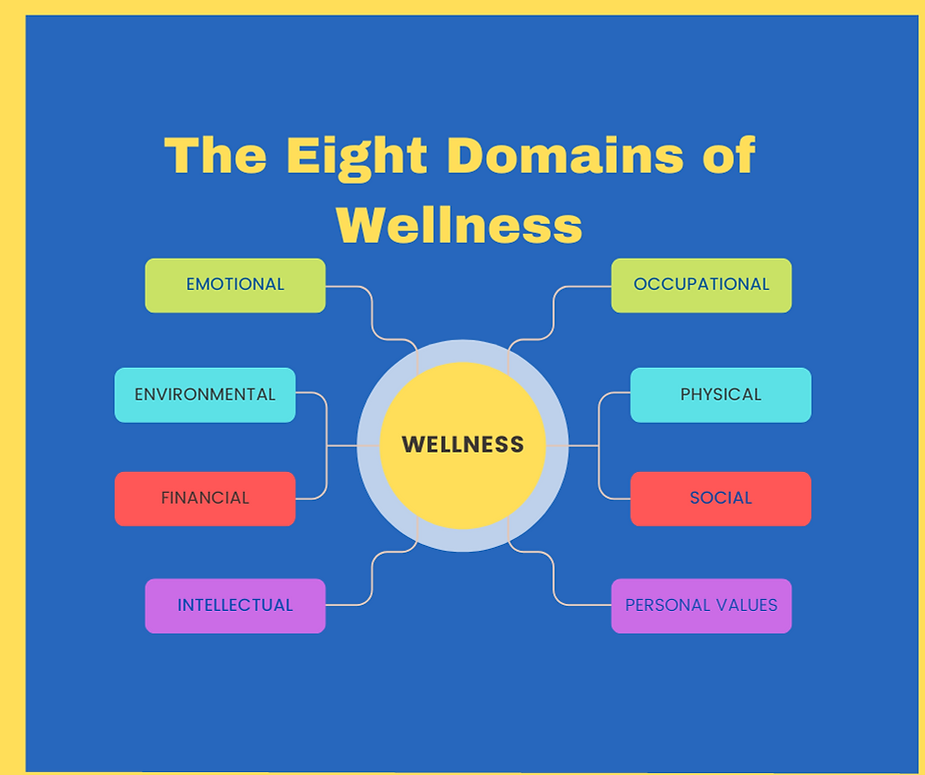
The concept of wellness has evolved beyond physical health and keeping your insurance premiums low. It now encompasses a whole-person approach that recognizes the intricate interplay among the most vital aspects of our lives.
The idea here is that Wellness is Wholeness (the terms are synonymous) and they emphasize the importance of integrating all necessary and applicable parts to create a cohesive and fulfilling existence.
In our rapidly accelerating world, we are spread thin and are easily fragmented. Being scattered across digital platforms, life commitments, and ensuring ourselves and loved ones are happy and whole is an ongoing endeavor. The solution is understanding that wellness is wholeness. We must constantly ask ourselves – what makes us whole? Let’s now explore the significance of embracing wholeness as a key to achieving true wellbeing through assimilating all necessary parts and domains.
“Health, wellness and wholeness is a lifelong process. It is understanding and connecting to the many sides of yourself, leading to a deep understanding and acceptance of your inner wisdom and to finding the balance that supports your life.” (Dossey, 2013)
Explain How Wellness is Wholeness
Wellness is Wholeness, encapsulates a philosophy advocating for a comprehensive approach to health that acknowledges the interconnection of the mind, body, and spirit. This concept promotes the idea that true well-being is achieved when these dimensions are in harmony. It urges individuals to consider various aspects of their lives, emphasizing preventative measures, lifestyle choices, family time, inner joy and practices that address the root causes of health issues. By embracing a proactive role in health, individuals can cultivate a balanced and gratifying life, moving beyond mere symptom management to a state of thriving.

What is Integrative Wellness
By properly decomposing health and wellness into smaller more-manageable parts, individuals can strive for a more complete and harmonious state of being. Wellness is wholeness means nurturing each aspect of life and personhood in a way that promotes overall balance, resilience, and fulfillment. It emphasizes a practical approach to taking care of ourselves and offers a sense of completeness in life.
It merges conventional and complementary therapies, emphasizing personalized care tailored to each-person’s needs. This method seeks to empower individuals through their wellness practices, encouraging proactive measures, preventive focus, and collaborative care involving a range of healthcare providers, holistic practitioners and all other essential people that make up one’s life.
How do the Trends of Traditional Wellness Fail Us
The concept of wholeness is presented as a departure from the relentless pursuit of self-improvement and the commodification of the wellness industry. The basis is self-acceptance and an understanding that allows us to relay this onto others without fear or resistance. We can cooperate and meet other humans on an honest emotional level while still progressing in our lives and achieving our goals.
Wholeness calls for a return to balance, reciprocity, and respect for all life forms, emphasizing the interconnectedness of human health with the health of the planet and its ecosystems. This shift from wellness to wholeness involves a deeper understanding of the self, a recognition of the spiritual and ancestral dimensions of well-being, and a rejection of the notion that external standards can validate one’s sense of completeness.
In recognizing part of the industry’s over-focus on self-optimization and the exhaustive effort of perfection, we highlight the disservice of planning every aspect of life and the restrictive nature of tracking and optimizing every decision. We must emphasize the importance of embracing uncertainty, relying on inner knowing, and finding peace through resilience and equanimity in the face of life’s challenges. Meaning that we will rely on our best practices and framework while knowing and accepting things can and will go wrong.

What Are the 8 Domains of Wellness
The concept of wellness is often categorized into various dimensions, pillars or domains, and while the exact pillars may vary in different models, one common framework is the Eight Dimensions of Wellness. These dimensions encompass various aspects of our lives and contribute to overall well-being. The Eight Pillars of Wellness typically include:
- Physical Wellness:Involves maintaining a healthy body through regular exercise, proper nutrition, adequate sleep, and avoiding harmful habits.
- Emotional Wellness:Focuses on understanding and managing one’s emotions effectively, cultivating resilience, and nurturing positive mental health.
- Social Wellness:Relates to building and maintaining healthy relationships, fostering a sense of belonging, and contributing to the community.
- Environmental Wellness:Encompasses creating a sustainable and supportive environment, including both the natural and built surroundings.
- Occupational Wellness:Involves finding fulfillment and satisfaction in one’s work or chosen vocation, as well as achieving a healthy work-life balance.
- Intellectual Wellness:Encourages continuous learning, curiosity, and engaging in intellectually stimulating activities to expand knowledge and skills.
- Financial Wellness:Relates to managing financial resources wisely, making informed decisions, and planning for both short-term and long-term financial goals.
- Personal Values or Spiritual Wellness:Focuses on finding meaning and purpose in life, exploring personal beliefs and values, and nurturing a sense of inner peace.
What Causes Fragmentation, Isolation and Displacement
Our life and wellbeing can face fragmentation when individuals grapple with challenges such as overcommitment without balance, inconsistent self-care practices, social isolation, and conflicting personal values. This fragmentation may also stem from inadequate integration of mindfulness, unhealthy lifestyle choices, a lack of purpose and meaning, and the neglect of mental health. These factors disrupt the harmonious interplay of different aspects of an individual’s existence, hindering the cohesive journey toward holistic well-being. We must recognize and reinforce the need for incorporating consistent self-care, fostering conscious social connections, aligning actions with values, living intentionally, making healthy lifestyle choices, and prioritizing mental health. All of this is supportive to the integrated path of how wellness is wholeness.
Living Healthy and Whole
How do we live healthy and whole? The idea is to embody a supportive lifestyle that prioritizes complete well-being across all dimensions while honoring who we are and where we come from. It means careful attention and proactive action on a regular basis. This approach emphasizes mindful choices, nourishing practices, and a harmonious balance between the most-essential aspects of life. It encourages individuals to view overall health and wellness as fostering a state of wholeness where vitality, mental clarity, and emotional resilience converge.
Through this perspective, the initiative “Living Healthy and Whole” aims to guide individuals on a transformative journey from wellness to wholeness that is first defined by their terms, while respecting the general outline of the wellness frameworks employed (8 domains, 7 pillars, or 6 dimensions).

To Be Well We Must Make Ourselves Whole
Genuine wellness arises from achieving completeness across all aspects of life—addressing physical health, nurturing emotional resilience, focusing on professional development, fostering sustainability, committing to lifelong learning and fiscal responsibility, cultivating meaningful social connections, and aligning with personal values and purpose. Making ourselves whole involves a proactive effort to integrate these dimensions, while recognizing their interdependence.
By embracing the holistic approach, individuals embark on a continuous journey toward authentic well-being, where each facet contributes to a harmonious and satisfying existence. In the quest of wellness, the guiding principle is the concept of wholeness, recognizing and integrating diverse facets—physical, mental, emotional, social, intellectual, professional, worldly, cultural, as well as values and virtues. Embracing wholeness is an ongoing pursuit toward a more meaningful and balanced life, acknowledging and integrating all the necessary parts that make up the intricate mosaic of our existence.
In summary, wholeness encompasses a movement towards greater integrity, health, and communion, as well as a recognition of the essential imperfection and grace inherent in everything. It involves an interior sense of completeness and sincerity, and it holds a special quality that extends beyond the commercialized notions of wellness.


